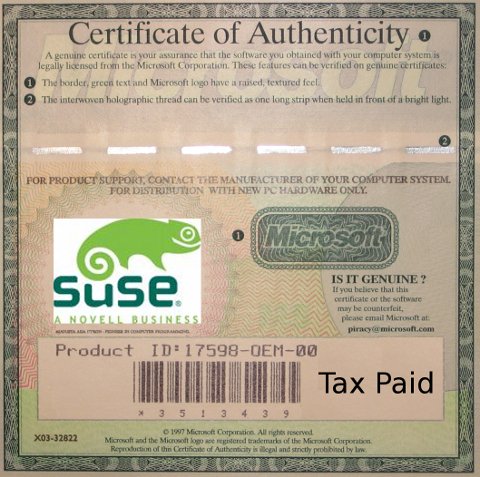11.23.11
SUSE Became a Niche Product/Market

Picture contributed by a reader
Summary: OpenSUSE numbers, some other SUSE news, and a few words about the status of the product
IT HAS been just over a week since OpenSUSE celebrated a new release, which was mostly covered by FOSS writers, e.g. [1, 2] (one needs to know authors’ names). The corporate press seems to pay attention only to Ubuntu releases. Some people upgrade their desktops and servers, so download numbers may not mean all that much (e.g. regarding growth). OpenSUSE did publish numbers:
Our download redirector counted for the first 24 hours the download of 93761 media, the distribution over the various types is:
* NonOss Addon CD BiArch: 1452
* 32-bit x86: 48075 (total)
o Net: 2489
o DVD: 31840
o GNOME-LiveCD: 7392
o KDE-LiveCD: 5561
o Addon-Lang: 793
* 64-bit x86-64: 44234 (total)
o Net: 2444
o DVD: 32927
o GNOME-LiveCD: 4031
o KDE-LiveCD: 4378
o Addon-Lang: 454
This is not particularly impressive, but there will always be someone begging to differ. Many downloads are for server setups or testing. In production environments CentOS is a lot more commonplace. Apart from the release there is almost no news. The release itself was mostly mentioned by SUSE sites like this or that, or even the official blog that speaks of Google funding (moving on to other topics):
Googles Code-in is a program aimed at pre-university students between the age of 13 and 17. It starts on the 21. November, 2011. For this program we provide a list of tasks that are both fun and challenging for the students. Students who work on these tasks get a designated mentor assigned who will guide and help them. The tasks students can pick vary from writing or re-factoring code to doing marketing for the project. Simply everything a FOSS project has to do. Students can of course select tasks according to their interests.
It would be wiser to help distributions that do not serve Microsoft’s agenda.
There is some packaging news [1, 2, 3, 4, 5, 6, 7, 8] and few reviews of the distribution. There are far fewer reviews than articles that just mention the release. In fact, we found less than a handful proper reviews. Not impressive at all…
Andrew Wafaa is running for the OpenSUSE Board as a non-employee, of which there are several who are enthusiastic to just spread OpenSUSE of all distributions (as misguided as that can be). There are also some HOWTOs out there [1, 2, 3] and an installation video for the new release. Banshee makes its appearance again in SUSE-affiliated blogs and Balsam does too. The SUSE blogs are by far the most dominant sources of news because OpenSUSE is hardly mentioned outside them. Novell’s PR is pretty much defunct and once in a matter of weeks we found them speaking about Vibe; well, they said they had axed it, but recently they mentioned it again. Novell just cannot seem to make up its mind. Given that the head of PR lost his job, it must be chaotic there.
The bottom line is, SUSE or OpenSUSE are not dominant. They were quite dominant before the Microsoft deal, which turned them into “niche” — a distribution for those wishing to pay Microsoft for GNU/Linux although they needn’t. █
































 Content is available under CC-BY-SA
Content is available under CC-BY-SA
Michael said,
November 23, 2011 at 11:51 am
As I showed, OpenSUSE was covered by far more than just FOSS writers – it was covered fairly well in the mainstream press, considering it is just a desktop Linux distro (something most people do not really care about).
As far as it being a niche, all desktop distros are.
mcinsand said,
November 23, 2011 at 12:57 pm
It took a long time, but people have learned. MS is an artist at using ‘interoperability’ as a tool for establishing dominant market share and then using extensions to eliminate interoperability. They did this in documents and spreadsheets; I remember when Word and Excel handle WordPerfect and 1-2-3 files better than the native applications. They tried this with Java, and they also tried unsuccesfully to take control of the C ecosystem. SUSE swallowed the .NET poison pill and, sadly, OpenSUSE was effectively tainted.
In the end, this will probably help the Linux community by reducing what some see as fragmentation, but others see as a healty, thriving competitive environment. And that is where MS and Apple come up empty-handed. Those two companies cannot compete but only suppress competition where possible… or where regulating authorities look the other way. They lag well behind Linux for growth and new ideas, where the GPL guarantees a constant intellectual reinvestment. Linux is their worst nightmare, because it now has enough of a community for stability, and they can’t crush it any more than they can honestly compete with it. If B&N wakes up the authorities the way we hope they will, Apple and MS are toast!
Michael Reply:
November 23rd, 2011 at 1:16 pm
Cannot compete? What world are you living in? Assuming you are talking desktop usage, Linux is pretty much non-existant, a rounding error’s worth of usage share. And that is being free. Compare that to OS X where the entry price is $1000 and up and it still have a pretty hefty market penetration.
Linux is spectacular. It is wonderful on super computers and embedded devices and servers and more. But on the desktop – no – except for some special use cases it simply does not compete. To turn this around, as you do, and claim MS and Apple are not competing well against desktop Linux is crazy talk. Nothing at all to back this up.